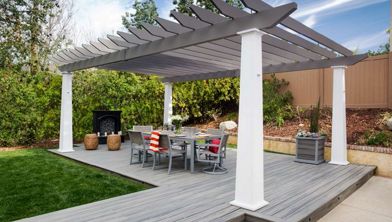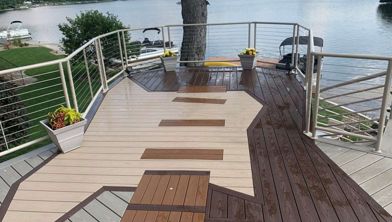Trex Innovation: From Plastic Bags to Composite Decking
The Origins of Trex Decking
In the late 1980s, as environmental awareness began to grow worldwide, one visionary recognized value in what others considered waste. With a background in science and a knack for innovation, he took piles of discarded plastic bags and turned them into the building blocks of a sustainable revolution. This vision became Trex — now the world’s leading brand of composite decking. The Trex story is one of ingenuity, perseverance, and the belief that sustainability and performance can go hand in hand.
Trex Company's Founding: Where Ingenuity Met Opportunity
Early Years of Composite Decking
With a background in organic chemistry, Philadelphia-based businessman Roger Wittenberg possessed the unique ability to dissect materials down to their core components and envision new, marketable uses. While he wasn’t necessarily an environmentalist, he believed in recycling as a way to drive both innovation and profit.
Never one to overlook an opportunity, Wittenberg turned his scientific curiosity to this new challenge. One of his early ventures involved supplying breadcrumbs to household names like Progresso, grinding up surplus bread from 20 tractor-trailers daily. This process left behind a mountain of empty plastic bread bags — and Wittenberg couldn’t help but see potential.
He shredded the leftover plastic, mixed in sawdust, and applied heat. The result was a sturdy, moldable, rot-resistant material that wouldn’t split or attract termites. Wittenberg called it Rivenite, and though early ideas like fire logs and park benches didn’t pan out, he kept pushing forward.
If you’re not failing and some things, you’re probably not trying. You’ve got to try a lot of things and pay attention.
Development of Trex Decking: From Rivenite to Residential Fame
How Trex Started to Scale
As the 1990s dawned, recycling grew into a movement and the word “green” was coined to describe eco-friendly products. It was now big business for corporations to reduce waste in both their packaging and manufacturing processes.
Mobil Chemical Company, a leading producer of household disposable plastics through brands like Hefty®, sought to increase its environmental capital among consumers by sourcing recycled materials that might otherwise end up in landfills. Executives sized up a possible strategic alignment between Mobil and Rivenite and, in 1992, the plastics conglomerate acquired the breakthrough technology for $10 million. This acquisition became the cornerstone for the creation of Mobil’s Composite Products Division, with the forward-thinking Wittenberg at its helm. His initial vision of commercializing waste had finally been realized.
With Mobil’s stewardship and financial backing, Rivenite evolved into TimbrexTM – a name evoking its realistic wood appearance. The first generation of Timbrex planks, manufactured in a 50,000-square foot production plant in Tampa, Fla., were marketed strictly for commercial applications, and found use in a variety of municipal and government projects. Architects and designers were drawn to the cost-effectiveness of its long-lasting good looks and low-maintenance requirements. It further proved its value by standing up to the harsh climate conditions of Florida and not degrading after continued exposure to sunlight, saltwater, moisture, or insects at high-profile installations like the walkways at Everglades National Park. At that time, Florida had robust recycling initiatives, providing ample plastic sources for the manufacturing of Timbrex, which quickly gained a reputation as a truly sustainable building material.
In 1994, Timbrex made its industry debut at the National Association of Home Builder’s Show (now the International Builders Show). Receiving positive feedback from hundreds of residential contractors, Andy Ferrari, a marketing executive with the Mobil Composite Products Division, experienced an ‘ah-ha moment’ that would change the course of the brand.
Founders of Trex and the Birth of a Brand
During registration, Ferrari mistakenly ended up in the contractor registration line instead of the line for exhibitors. He overheard several contractors discussing the positive attributes of Timbrex. Over the next few days, even though the brand only had a small 10’x20’ display space, and an equally minute advertisement in the exhibitor directory, more than 1,400 show attendees visited its booth. This was a clear tipping point, indicating that the product was ready to take on the lucrative residential sector.
Almost simultaneously, Mobil executives received notice that a company in the United Kingdom already owned the rights to the Timbrex name. They faced a daunting three-day deadline to develop a new brand identity that would be distinct, relevant, and long-lasting.
Ferrari brainstormed numerous options, and landed on three finalists that he presented to a team, which included Wittenberg. They quickly decided to contract "Timbrex" into "Trex," reasoning that a durable brand should have a unique name without any pre-existing meaning. The fact that "Trex" rhymed with "decks" made it even more appealing. Ironically, the soundness of this executive-level decision was reinforced by Ferrari’s young daughter, who also selected Trex from the list of top contenders – associating it with the formidable T-Rex dinosaur.
If a brand is going to be ingrained in the minds of consumers, it’s best that it be a word that doesn’t mean anything else. The fact that ‘Trex’ rhymed with decks made it stick.
With a new, consumer-friendly brand name for its composite product, Mobil set out to win over the layers of industry professionals who influence homeowner decisions. Its robust sales force infiltrated building-supply distributors and professional lumberyards, while Trex starred in a slick trade media advertising campaign specifically targeting decking contractors. Soon, the Tampa manufacturing facility closed, and production was consolidated in a new plant in Winchester, Va., that boasted twice the square footage. By year’s end, Trex’s popularity had skyrocketed, with an impressive $8 million in orders – a quantum leap from the $600,000 that Timbrex earned only two years earlier.
Timeline of Trex Innovations: From IPO to Iconic Products
Building a Global Eco-Empire
The Trex brand was booming, ready to stand on its own name and accolades. In 1996, four bold senior executives from Mobil – including Wittenberg and Ferrari – accomplished a successful leveraged buyout to become Trex Company, LLC. Establishing its headquarters in Winchester, the fledgling company began a period of strong and steady growth, supported by strategic marketing initiatives, that led to an impressive initial public stock offering (IPO) in 1999. This well-played maneuver opened up additional avenues of expansion.
Trex’s IPO placed it squarely on investors’ radar screens, and the company launched an aggressive consumer-facing print advertisement campaign to showcase the benefits of a decking product that combined the best qualities of wood and PVC. Soon, market demand far exceeded production capabilities. To meet this explosive growth, Trex opened a second manufacturing facility located in Fernley, Nev., in 1999 to better serve distributors and customers in the western half of the U.S.
We marketed to consumers when all of the other companies were talking to contractors. Decking was strictly a commodity product until Trex came along.
Product Breakthroughs and Industry Leadership
Through strategic investment in brand building, Trex became a household name earning category-synonymous status similar to Kleenex® and Band-Aid®. A decade after its IPO, the company once again made waves in the industry, unveiling its revolutionary Trex Transcend® decking in 2009. Engineered with a proprietary integrated shell, this game-changing product raised the bar on both aesthetics and performance by protecting against color fading, stains, and wear and tear while also delivering strikingly realistic wood looks with authentic grain patterns and sumptuous, nature-inspired colors. Visually pleasing, unbeatably durable and exceptionally easy to maintain, Trex Transcend secured its place at the forefront of the composite decking industry. In the decade that followed, Trex sales increased exponentially and, in 2021, the company reached a major milestone surpassing $1 billion in annual revenue.
Never content to rest on its laurels, Trex revolutionized the category yet again in 2023 with the introduction of Trex Signature® decking. A watershed moment for both the company and the composite decking industry as a whole, Trex Signature set a new standard for aesthetics with the achievement of the most authentic wood aesthetics to date. An altogether new decking material, Signature decking is crafted with the natural look of interior hardwoods but engineered to withstand the elements and demands of the outdoors.
Sustainability at the Core of Trex
And it’s all done with a deep understanding of environmental impact. In fact, the entire portfolio of Trex composite decking is made from up to 95% recycled and reclaimed materials, including reclaimed sawdust and scrap from woodworking operations and recycled plastic film from commercial packaging and common household items, such as plastic shopping bags, produce bags and sandwich bags, along with newspaper sleeves, dry cleaner bags, case overwrap, bubble wrap and flexible shipping pouches. Each year, Trex uses more than 1 billion pounds of these would-be waste materials in the making of its outdoor living products and has diverted more than 5.5 billion pounds of plastic waste from landfills and waterways since its inception.
One of the largest recyclers of polyethylene film in North America, Trex continually seeks new sources of flexible plastic for its raw material stream. Through its NexTrex® Recycling Program, the company partners with major retailers, manufacturers, and distribution centers along with universities, businesses, and non-profit organizations to help them responsibly dispose of discarded plastic material used in packing and shipping. Trex also collects post-consumer plastic film through a network of more than 32,000 collection stations at stores and distribution centers across the U.S. and Canada. Additional plastic film is collected through hundreds of grassroots and community recycling initiatives across the country.
We’re not mining anything out of the ground or importing it. We’re adding value to waste materials and putting them back into society as something better. That is something I’m especially proud of and makes me feel like I’ve been part of something good.
Forging the Future of Composite Decking: The Next Chapter for Trex
For more than 30 years, Trex Company has invented, reinvented and defined the composite decking category. Today, Trex is the world’s #1 brand of wood-alternative decking but also a leader in high-performance, low-maintenance, eco-friendly outdoor living products with a robust portfolio that includes railing, deck drainage, LED lighting, outdoor kitchen components, pergolas, spiral stairs, fencing, lattice, and outdoor furniture – all marketed under the Trex® brand and designed to deliver complete and cohesive outdoor living solutions for homeowners. This diverse product line speaks volumes about Trex’s continued ability to anticipate and fulfill the evolving needs of its customers.
And the company’s trailblazing journey is far from over. Trex has ambitious expansion plans including the development of a new state-of-the-art manufacturing campus in Little Rock, Ark., set to begin operations later this year. This will be the company’s third U.S.-based production facility. New products, online tools, and helpful resources are also in the works with a focus on making it as easy as possible for homeowners to achieve their dream outdoor spaces with Trex no matter the size of their backyard, build, or budget.
Roger Wittenberg’s transformation of leftover plastic bread bags into what would become Trex composite decking proved that environmental responsibility can coexist with remarkable business success. With 1,700 employees worldwide, products sold through more than 6,700 retail outlets across six continents, and industry-leading sales performance year after year, Trex’s story serves as an inspiring reminder that great achievements are possible when we dare to think differently and prioritize our planet.
From bread bags to billion-dollar innovation, Trex has proven that eco-consciousness and entrepreneurial thinking can shape an industry — and redefine how we build the world around us.
Explore our industry-leading portfolio of high-performance, low-maintenance decking and outdoor living products—designed to outlast, outperform, and outshine traditional wood.
This content was partially or fully generated by AI and has been reviewed by our team to ensure accuracy and relevance.







































